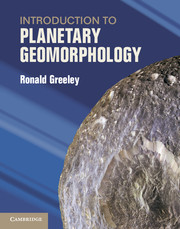Book contents
- Frontmatter
- Contents
- Foreword
- Preface
- Acknowledgments
- Chapter 1 Introduction
- Chapter 2 Planetary geomorphology methods
- Chapter 3 Planetary morphologic processes
- Chapter 4 Earth’s Moon
- Chapter 5 Mercury
- Chapter 6 Venus
- Chapter 7 Mars
- Chapter 8 The Jupiter system
- Chapter 9 The Saturn system
- Chapter 10 The Uranus and Neptune systems
- Chapter 11 Planetary geoscience future
- Appendices
- References
- Further Reading
- Index
Chapter 9 - The Saturn system
Published online by Cambridge University Press: 05 February 2013
- Frontmatter
- Contents
- Foreword
- Preface
- Acknowledgments
- Chapter 1 Introduction
- Chapter 2 Planetary geomorphology methods
- Chapter 3 Planetary morphologic processes
- Chapter 4 Earth’s Moon
- Chapter 5 Mercury
- Chapter 6 Venus
- Chapter 7 Mars
- Chapter 8 The Jupiter system
- Chapter 9 The Saturn system
- Chapter 10 The Uranus and Neptune systems
- Chapter 11 Planetary geoscience future
- Appendices
- References
- Further Reading
- Index
Summary
Introduction
Saturn is an enormous planet, second in diameter only to Jupiter. From the discovery of rings around Saturn nearly 400 years ago until the last three decades when rings were found around the other giant planets, Saturn was thought to be unique in the Solar System. Saturn has at least 62 satellites, including Titan, which has global clouds and an atmosphere denser than that of Earth, and the moon Enceladus with its actively spewing geysers. Titan is the only outer planet moon on which a spacecraft has landed. Consequently, the Saturn system holds a special place in our view of the Solar System.
Exploration
When Galileo viewed Saturn through his telescope for the first time in 1610, he apparently thought he was seeing three separate objects, but later observations led to his publishing a sketch in 1616 that clearly showed Saturn and its ring system. Rapid improvements in telescopes and their application to planetary observations resulted in more detailed descriptions of Saturn and prompted wide speculation on the origin and characteristics of its system of rings.
Exploration of the Saturn system by spacecraft began with the Pioneer 11 flyby in 1979, followed by Voyager 1 and Voyager 2 in 1980 and 1981, respectively. Pioneer 11 data yielded new insight into the magnetic field generated by the planet and enabled the discovery of the F Ring. The Voyager spacecraft returned the first clear images that revealed the great geologic diversity of Saturn’s satellites.
- Type
- Chapter
- Information
- Introduction to Planetary Geomorphology , pp. 177 - 200Publisher: Cambridge University PressPrint publication year: 2013



